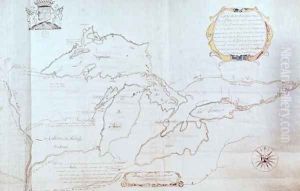Jolliet Paintings
Louis Jolliet, also known as Louis Joliet, was not an artist in the traditional sense of painting, sculpture, or visual arts but was a notable historical figure as an explorer of French-Canadian descent. He was born on September 21, 1645, in Quebec City, which was then part of New France. Jolliet's early education was at a Jesuit seminary in Quebec, and he was initially trained to become a priest. However, his interests shifted towards exploration and the study of the natural world, leading him to become a fur trader and explorer.
Jolliet is most famous for his 1673 expedition with the Jesuit priest Father Jacques Marquette, where they set out to discover the Mississippi River, which was rumored to flow into the Pacific Ocean. The expedition was significant for European exploration of North America as it helped to map the Mississippi River and opened up new territories for trade and settlement.
During their journey, Jolliet and Marquette traveled from the Great Lakes down the Mississippi to the Arkansas River, and they became the first Europeans to provide detailed accounts of its course. They concluded that the Mississippi must flow into the Gulf of Mexico, not the Pacific Ocean as previously believed, which was an important discovery for the understanding of North American geography at the time.
After the expedition, Jolliet returned to New France and was appointed as the royal hydrographer. He continued to explore, including a trip to the Hudson Bay and a journey to map the coast of Labrador. Despite his accomplishments as an explorer, Jolliet suffered misfortune when he lost his journals and maps from the Mississippi expedition in a shipwreck on the St. Lawrence River.
Jolliet's legacy as an explorer is significant, and he is remembered for his contributions to the mapping and understanding of North America. He died on May 1700, in Quebec. Although Jolliet was not an artist in the conventional sense, his exploration and mapping can be seen as a form of documenting and interpreting the natural world, which is an essential aspect of the cultural history.
